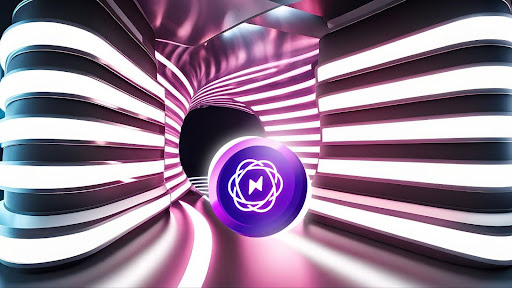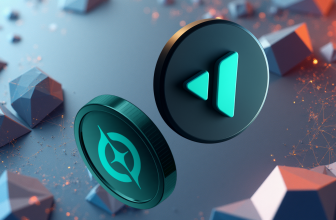
The cryptocurrency and blockchain landscape is rapidly evolving, with projects like Solana (SOL) and Lightchain AI poised to redefine efficiency and scalability. Lightchain AI, currently in its presale phase, introduces a revolutionary ecosystem powered by AI and blockchain to address Ethereum’s challenges in scalability, privacy, and efficiency.
With groundbreaking features like Proof of Intelligence (PoI) and the Artificial Intelligence Virtual Machine (AIVM), Lightchain AI integrates advanced AI computations into a transparent, decentralized framework. Similarly, Solana’s high-speed blockchain capabilities continue to challenge Ethereum’s dominance, showcasing the potential of innovative protocols to transform the future of decentralized ecosystems.
What you'll learn 👉
Ethereum (ETH): The Benchmark and Its Limitations
Ethereum (ETH) is a leading blockchain platform known for its smart contract functionality and decentralized applications (dApps). Its native cryptocurrency, Ether, is central to decentralized finance (DeFi) and non-fungible tokens (NFTs).
However, Ethereum faces challenges like scalability, with a limit of about 25 transactions per second, causing congestion and high fees during peak times. Security concerns, such as The DAO hack in 2016, have also raised issues about smart contract vulnerabilities.
The ongoing shift from proof-of-work to proof-of-stake aims to reduce energy consumption but introduces new complexities and potential centralization risks. Despite these challenges, Ethereum remains dominant in the blockchain space, with a total value locked of $46 billion, reflecting its widespread use and resilience.
Solana (SOL): High-Performance Contender
Solana (SOL) is a blockchain platform built to solve scalability and transaction speed issues seen in earlier networks like Ethereum. Launched in 2020, Solana stands out for its ability to deliver fast, low-cost transactions.
Key Features of Solana:
- Proof of History (PoH): A unique consensus mechanism that timestamps transactions, allowing validators to process them efficiently without extensive communication.
- High Throughput: Combining PoH with Proof of Stake (PoS), Solana can handle over 65,000 transactions per second (TPS) in test conditions, enabling smooth dApp performance.
- Low Fees: Solana’s average transaction cost is just $0.00025, making it highly appealing for developers and users.
- Scalable Architecture: Features like Sealevel enable parallel processing of smart contracts, improving efficiency and scalability.
- Developer-Friendly Tools: With resources like the Solana Software Development Kit (SDK) and support for Rust and C, the platform is ideal for creating high-performance dApps.
Solana’s focus on speed, low costs, and scalability makes it a strong contender in the blockchain space and a popular choice for developers.
Lightchain AI: The Emerging Challenger
Lightchain AI combines blockchain and artificial intelligence to redefine the potential of decentralized systems. Available through its presale, it tackles key challenges like scalability, privacy, fairness, and transparency, unlocking new possibilities for dApps and governance.
Two core features drive Lightchain AI: Proof of Intelligence (PoI) and the Artificial Intelligence Virtual Machine (AIVM). PoI rewards nodes for performing meaningful AI tasks like model training and optimization, replacing traditional mining or staking. AIVM is a computational layer optimized for executing AI tasks with low latency, supporting frameworks like TensorFlow and PyTorch. These features position Lightchain AI as an innovative solution for decentralized AI development.

Comparing Ethereum, Solana, and Lightchain Al
As of December 10, 2024, the blockchain space is led by platforms like Ethereum and Solana, each offering unique features. Joining them is Lightchain AI, a new player combining blockchain with artificial intelligence (AI).
This article compares these three platforms, focusing on architecture, consensus mechanisms, scalability, transaction costs, ecosystem growth, and security.
1. Architecture and Consensus Mechanisms
- Ethereum: Launched in 2015, Ethereum introduced smart contracts for decentralized applications (dApps). It transitioned from Proof of Work (PoW) to Proof of Stake (PoS) with Ethereum 2.0, improving scalability and energy efficiency. Validators stake ETH to propose and verify new blocks.
- Solana: Founded in 2020, Solana uses Proof of History (PoH) combined with Proof of Stake (PoS). PoH timestamps transactions with a cryptographic clock, enabling high speeds and low latency. Solana processes thousands of transactions per second, making it one of the fastest blockchains.
- Lightchain AI: Lightchain AI integrates AI into its blockchain, introducing Proof of Intelligence (PoI), which rewards nodes for performing AI tasks like model training. This boosts security while advancing AI development.
2. Scalability and Transaction Speeds
- Ethereum: Processes about 280 transactions per second (TPS) with confirmation times of 5 to 20 seconds. Scalability is being improved with Layer-2 solutions and sharding to boost throughput and reduce congestion.
- Solana: Solana boasts up to 65,000 TPS theoretically, with real-world speeds around 800 TPS. Transactions confirm in about 400 milliseconds, suitable for high-frequency applications.
- Lightchain AI: Scalability metrics for Lightchain AI are not yet available due to its early stage. Its design prioritizes efficient handling of AI tasks, which may affect transaction speeds.
3. Transaction Costs
- Ethereum: Gas fees vary with network demand, ranging from under $1 to double digits during busy times, which can deter smaller transactions.
- Solana: Solana offers consistently low fees, around $0.00025 per transaction, ideal for high-volume applications.
- Lightchain AI: Information on Lightchain AI’s fees is not yet available. Its focus on AI tasks may lead to a unique fee structure.
4. Ecosystem and Development
- Ethereum: Ethereum supports over 4,700 dApps and has a large developer community. It leads in decentralized finance (DeFi) with the highest total value locked (TVL).
- Solana: Solana’s ecosystem is growing rapidly, focusing on DeFi and NFTs. Its speed and low costs attract developers and users.
- Lightchain AI: Still in its early stages, Lightchain AI hopes to attract projects leveraging AI and machine learning, setting it apart from existing platforms.
5. Security and Decentralization
- Ethereum: With a large number of validators and a robust PoS mechanism, Ethereum ensures strong security and decentralization. Its extensive network enhances its resilience against attacks.
- Solana: Solana’s higher hardware requirements limit the number of nodes, raising concerns about centralization. However, it maintains a solid security framework to counter threats.
- Lightchain AI: The security and decentralization of Lightchain AI will depend on how its PoI consensus mechanism and node distribution are implemented.
Ethereum, Solana, and Lightchain AI approach blockchain technology in unique ways. Ethereum’s established ecosystem and ongoing scalability upgrades make it a leader in decentralized applications. Solana’s high throughput and low transaction costs make it ideal for applications needing fast, low-cost transactions. Lightchain AI combines blockchain with AI, potentially opening doors to decentralized intelligence.
Will Solana and Lightchain AI Overtake Ethereum?
The blockchain space is evolving, with platforms like Solana and Lightchain AI addressing Ethereum’s current limitations. Ethereum, the pioneer of smart contracts, has a mature ecosystem, strong developer support, and dominance in decentralized finance (DeFi). However, challenges with scalability and high transaction costs persist, even with Ethereum 2.0’s transition to Proof of Stake (PoS).
Solana offers high throughput and low transaction costs, enabling thousands of transactions per second at minimal fees. With its Proof of History (PoH) and Proof of Stake (PoS) mechanisms, it’s well-suited for high-frequency, cost-sensitive use cases.
Lightchain AI introduces new possibilities by embedding artificial intelligence into blockchain operations. Through its Proof of Intelligence (PoI) mechanism, nodes are rewarded for AI computations, while the Artificial Intelligence Virtual Machine (AIVM) streamlines AI tasks. This positions Lightchain AI as a disruptor, targeting the intersection of blockchain and decentralized AI.
While Ethereum remains dominant, the growth of Solana and the potential of Lightchain AI highlight rising competition. Whether they surpass Ethereum depends on their ability to scale, innovate, and attract vibrant ecosystems.
What Gives Lightchain AI Its Competitive Advantage?
Lightchain AI stands out by integrating AI with blockchain technology, addressing key challenges like scalability, privacy, and transparency. Its Proof of Intelligence (PoI) consensus mechanism rewards nodes for valuable AI computations, advancing decentralized AI.
At the heart of the platform is the Artificial Intelligence Virtual Machine (AIVM), optimized for AI tasks to enable real-time applications. Its Transparent AI Framework ensures open, auditable, and accountable operations, while its decentralized governance model promotes community-driven decision-making. Lightchain AI bridges AI and blockchain, creating a scalable, innovative platform for the future.
Why Invest in Lightchain Protocol AI Now?
Investing in Lightchain AI offers a chance to be part of the next wave of blockchain technology. By combining AI and blockchain, Lightchain AI brings unique advantages, making it an attractive investment. Here’s why it’s worth considering:
- Early Stage Opportunity: Lightchain AI is in its early development, giving investors a chance to join its growth journey from the start.
- Disruptive Innovation: By integrating AI with blockchain, Lightchain AI could revolutionize both industries, opening doors to significant growth and adoption.
- Potential High Returns: With rising demand for AI and decentralized applications, Lightchain AI offers potential for strong returns as it matures and attracts more projects.
- Expanding Ecosystem: As more developers and projects join, Lightchain AI’s ecosystem is growing rapidly, boosting adoption and investor value.
- Competitive Edge: Features like the Proof of Intelligence (PoI) consensus mechanism and Artificial Intelligence Virtual Machine (AIVM) give Lightchain AI a unique advantage in the market.
- Strong Team: A team of seasoned experts in blockchain, AI, finance, and technology backs Lightchain AI, laying a solid foundation for success.
With these factors, Lightchain AI is a compelling investment in the evolving blockchain space. As industries continue to adopt AI, Lightchain AI’s innovative approach positions it as a long-term opportunity.
Final Thoughts
The race for blockchain efficiency is heating up as Solana and Lightchain AI tackle Ethereum’s scalability and cost issues. Solana’s fast, low-cost infrastructure provides immediate solutions, while Lightchain AI brings a groundbreaking edge with its AI integration, PoI, and AIVM.
These platforms are driving the next evolution in blockchain, expanding what decentralized systems can achieve. Ethereum remains strong with its developer community, but its future depends on overcoming scalability and cost challenges. The blockchain ecosystem is set for exciting advancements fueled by innovation and efficiency.
Don’t miss your chance—participate in the Lightchain AI presale today! Be part of a groundbreaking crypto revolution, merging blockchain technology with artificial intelligence.
DISCLAIMER: CAPTAINALTCOIN DOES NOT ENDORSE INVESTING IN ANY PROJECT MENTIONED IN SPONSORED ARTICLES. EXERCISE CAUTION AND DO THOROUGH RESEARCH BEFORE INVESTING YOUR MONEY. CaptainAltcoin takes no responsibility for its accuracy or quality. This content was not written by CaptainAltcoin’s team. We strongly advise readers to do their own thorough research before interacting with any featured companies. The information provided is not financial or legal advice. Neither CaptainAltcoin nor any third party recommends buying or selling any financial products. Investing in crypto assets is high-risk; consider the potential for loss. Any investment decisions made based on this content are at the sole risk of the readCaptainAltcoin is not liable for any damages or losses from using or relying on this content.







